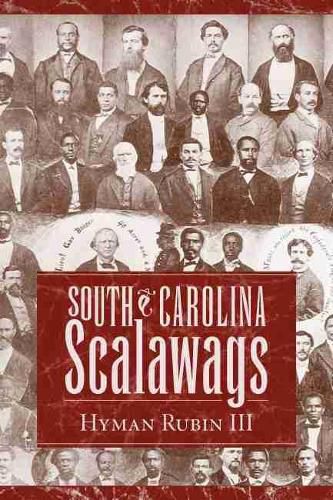Readings Newsletter
Become a Readings Member to make your shopping experience even easier.
Sign in or sign up for free!
You’re not far away from qualifying for FREE standard shipping within Australia
You’ve qualified for FREE standard shipping within Australia
The cart is loading…






South Carolina Scalawags tells the familiar story of Reconstruction from a mostly unfamiliar vantage point, that of white southerners who broke ranks and supported the newly recognized rights and freedoms of their black neighbors.
The end of the Civil War turned South Carolina’s political hierarchy upside down by calling into existence what had not existed before, a South Carolina Republican Party, and putting its members at the helm of state government from 1868 to 1876. Composed primarily of former slaves, the burgeoning party also attracted the membership of newly arrived northern carpetbaggers and of white South Carolinians who had lived in the state prior to secession. Known as scalawags, these South Carolinians numbered as many as ten thousand-fifteen percent of the state’s white population-but have remained a maligned and largely misunderstood component of post-Civil War politics. In this first book-length exploration of their egalitarian objectives and short-lived ambitions, Hyman Rubin III resurrects the lives and careers of these individuals who took a leading role during Reconstruction.
South Carolina Scalawags delves into the lives of representative white Republicans, exploring their backgrounds, political attitudes and actions, and post-Reconstruction fates. The Republicans succeeded in creating a much more representative and responsive government than the state had seen before or would see for generations. During its heyday the party began to attract wealthier white citizens, many of whom were moderates favoring cooperation between open-minded Democrats and responsible Republicans.
In assessing the eventual Republican collapse, Rubin does not gloss over disturbing trends toward factionalism and corruption that increasingly characterized the party’s governance. Rather he points to these failings in explaining the federal government’s abandonment of the party in 1876 and the Democrats’ reassertion of white supremacy.
$9.00 standard shipping within Australia
FREE standard shipping within Australia for orders over $100.00
Express & International shipping calculated at checkout
South Carolina Scalawags tells the familiar story of Reconstruction from a mostly unfamiliar vantage point, that of white southerners who broke ranks and supported the newly recognized rights and freedoms of their black neighbors.
The end of the Civil War turned South Carolina’s political hierarchy upside down by calling into existence what had not existed before, a South Carolina Republican Party, and putting its members at the helm of state government from 1868 to 1876. Composed primarily of former slaves, the burgeoning party also attracted the membership of newly arrived northern carpetbaggers and of white South Carolinians who had lived in the state prior to secession. Known as scalawags, these South Carolinians numbered as many as ten thousand-fifteen percent of the state’s white population-but have remained a maligned and largely misunderstood component of post-Civil War politics. In this first book-length exploration of their egalitarian objectives and short-lived ambitions, Hyman Rubin III resurrects the lives and careers of these individuals who took a leading role during Reconstruction.
South Carolina Scalawags delves into the lives of representative white Republicans, exploring their backgrounds, political attitudes and actions, and post-Reconstruction fates. The Republicans succeeded in creating a much more representative and responsive government than the state had seen before or would see for generations. During its heyday the party began to attract wealthier white citizens, many of whom were moderates favoring cooperation between open-minded Democrats and responsible Republicans.
In assessing the eventual Republican collapse, Rubin does not gloss over disturbing trends toward factionalism and corruption that increasingly characterized the party’s governance. Rather he points to these failings in explaining the federal government’s abandonment of the party in 1876 and the Democrats’ reassertion of white supremacy.